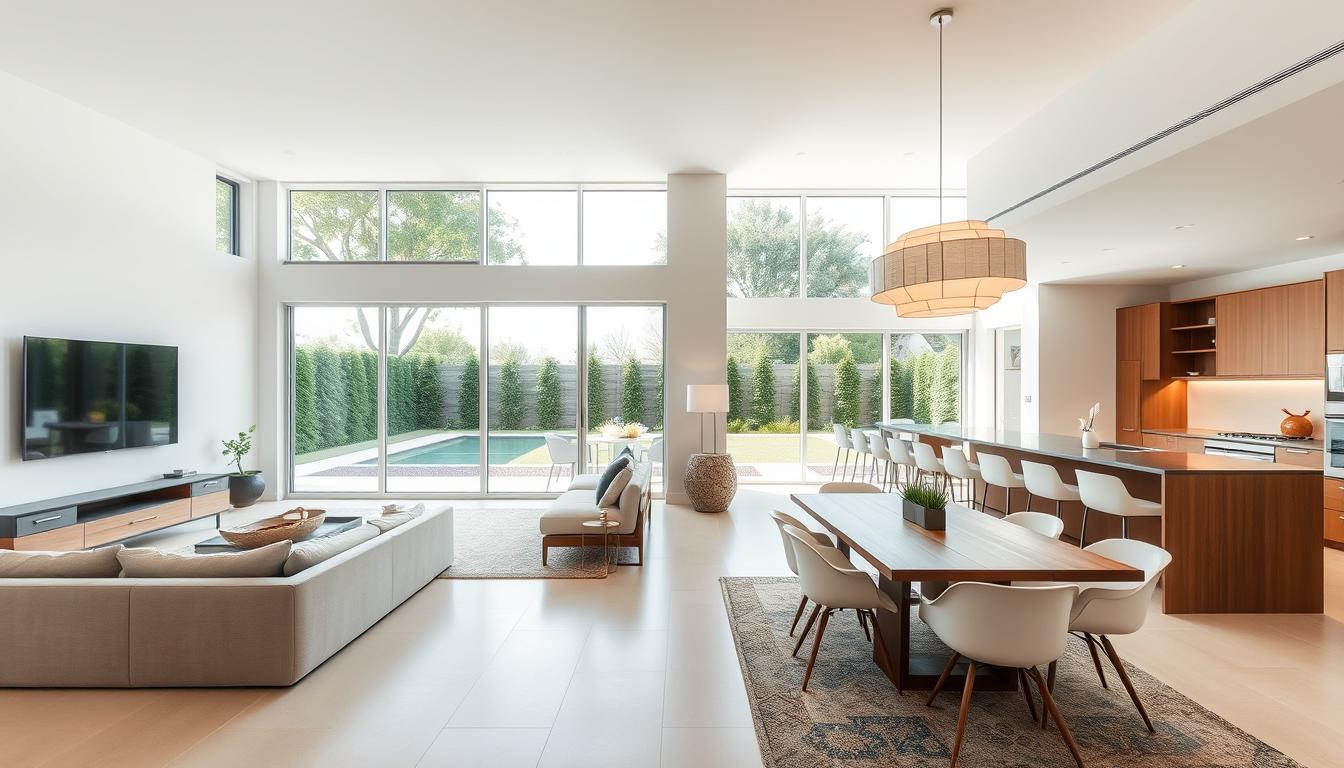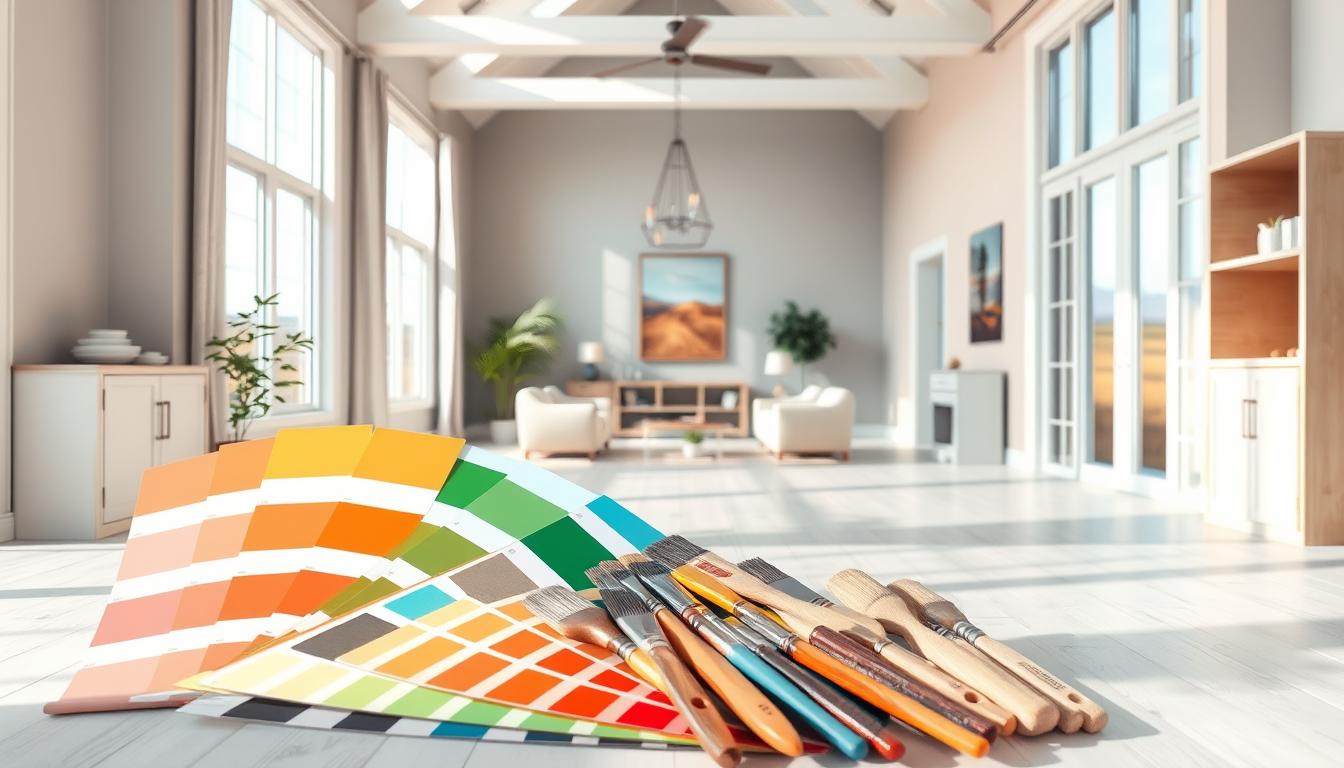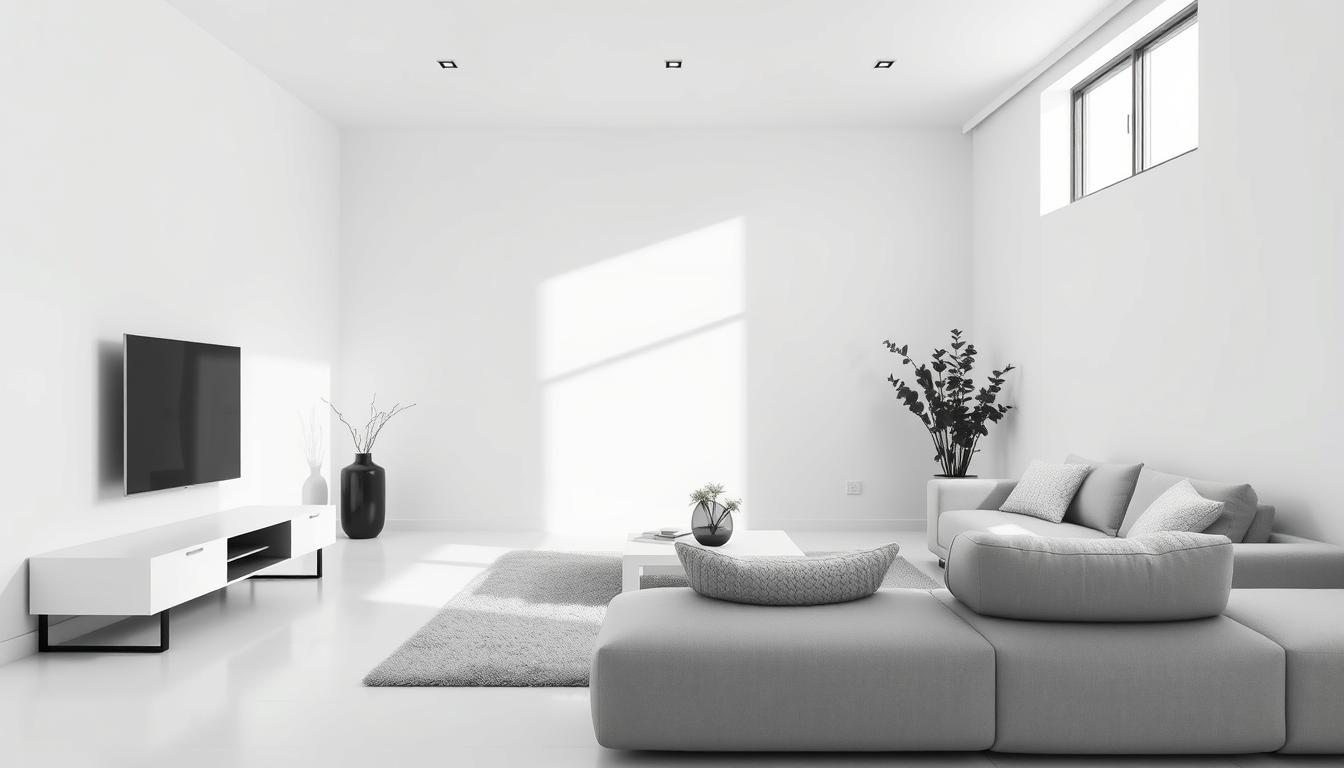Did you know a well-designed living space can make you happier and more productive? A stylish and functional area is more than just looks. It can really change your life. At our platform, we know how key modern home design is in making a space that shows who you are and works for you.
We’ll share our best tips for a stylish and useful living space. By using these expert tips, you can turn your living area into a haven that looks great and works well. For more ideas, check out our collection of home interior ideas.
Key Takeaways
- Understand the principles of modern home design
- Learn how to choose a color palette that enhances your space
- Discover the importance of lighting in home interior design
- Explore ways to incorporate texture and pattern into your decor
- Find out how to balance style and functionality in your living area
Understanding Home Interior Design Principles
Effective interior design is based on several key principles. These principles help create a space that is both beautiful and functional. They are the foundation of beautiful homes.
Importance of Balance in Interior Design
Balance is key in interior design. It’s about how visual elements are spread out in a room. It brings stability and harmony.
There are three main types of balance: symmetrical, asymmetrical, and radial. Symmetrical balance uses mirroring to create a formal look. Asymmetrical balance uses different elements to create a dynamic space.
The Role of Proportion and Scale
Proportion and scale are crucial. They ensure furniture and decor fit well with the room. Proportion is about the size of elements in a room. Scale is about the size of an object compared to the space and other objects.
Good proportion and scale prevent a room from feeling too full or too empty. For example, a big sofa might overwhelm a small room. A tiny coffee table might get lost in a big room.
- Choose furniture that is appropriately sized for the room.
- Consider the scale of decorative elements like artwork and accessories.
- Use a mix of large and small pieces to create visual interest.
Color Theory Basics for Home Interiors
Color theory is essential in interior design. It affects the mood and feel of a room. The color wheel helps pick colors that go well together.
“The right color palette can transform a space, making it feel more expansive, cozy, or vibrant, depending on the desired effect.”
Knowing color theory helps create a cohesive color scheme. It’s about the psychological effects of colors and the 60-30-10 rule. It also considers the impact of light on color.
Developing Your Personal Style
Your personal style is the heart of your home’s décor. It makes your space unique and shows your personality. To develop it, you need to find your design influences, add personal touches, and explore different styles.
Identifying Design Influences
First, find the design influences that speak to you. This could be a style like modern or traditional, or a designer you love. Look at design magazines, websites, and social media to see what catches your eye. Note the colors, furniture shapes, and textures you like.
Incorporating Personal Touches
Adding personal touches makes a house a home. It’s about including items that tell your story or hold special meaning. This could be family heirlooms, artwork, or collectibles that bring character to your space. Choose items that fit your home’s overall look and feel.
Exploring Different Design Eras
Exploring different design eras can also add to your style. You might love the Victorian era’s elegance, the Mid-Century Modern’s simplicity, or Art Deco’s opulence. Mixing elements from different eras can make your space unique and interesting.
By finding your design influences, adding personal touches, and exploring different styles, you can create a personal style for your home. This approach not only makes your space look great but also makes it more meaningful and comfortable for you and your family.
Choosing the Right Color Palette
A well-chosen color palette is key to a harmonious home. The colors we pick for walls, furniture, and decor greatly affect our space’s feel and look.
Psychological Effects of Colors
Colors deeply influence our emotions and mood. For example, blue brings calmness and serenity, perfect for bedrooms. Red, on the other hand, boosts energy and passion, great for living areas or gyms. Knowing how colors affect us helps us choose wisely.
Tips for Creating Harmony
To create harmony with colors, follow these tips:
- Choose a main color and one or two accent colors to prevent too much.
- Adopt the 60-30-10 rule: 60% main color, 30% secondary, and 10% accent.
- Use a color wheel to find colors that go well together.
Using Neutrals vs. Bold Colors
The choice between neutrals and bold colors is a big one. Neutrals like beige, white, and gray are timeless and versatile. They’re great for minimalist designs, creating a clean, serene feel. Bold colors, on the other hand, add character and personality. They make great focal points and add depth.
By understanding color psychology, using harmony tips, and choosing between neutrals and bolds, we can create a color palette that enhances our home’s beauty and our well-being.
Selecting Furniture Wisely
Choosing the right furniture is all about finding the right mix of looks and use. When picking out furniture for your home, think about what looks good and what works well. This ensures your furniture is both beautiful and useful.
Prioritizing Functionality
Function should be your top concern when picking out furniture. It’s not just about looks; it’s about how well it works. For example, a sofa needs to be comfy, and a coffee table should be easy to use from both sitting and standing.
Think about what you’ll do in each room and what furniture you need for those activities. For example, if you work from home, you’ll need a good desk and chair.
The Importance of Quality Materials
The quality of materials in your furniture matters a lot. Good materials last longer and often look better over time. For instance, solid wood furniture gets a nice patina, while cheaper materials might not last.
Look for furniture made from durable, sustainable materials. Check for strong build, smooth finishes, and comfy seats. Spending more on quality materials might seem pricey at first, but it saves money in the long run by avoiding frequent replacements.
Mixing Styles for a Unique Look
Mixing styles can make your space truly unique. Combining different styles adds depth and character. But, it’s important to do it carefully to avoid a messy look.
To mix styles well, start with something that ties everything together, like a common color or texture. Then, add pieces that complement each other. For example, a modern sofa and a vintage armchair can create a cool contrast. The goal is to find a balance that shows off your personal style.
Maximizing Space Efficiently
To make your home feel bigger and more organized, you need a good plan. We’ll look at how to use your space well. This includes smart storage, arranging furniture right, and making the most of the walls.
Clever Storage Solutions
Using smart storage is key to a bigger home. Think about furniture that does more than one thing, like ottomans with storage or beds with drawers. Choosing furniture that has multiple uses can cut down on mess and free up space.
Hidden storage spots, like under-bed bins or secret drawers, are also great. Labeling your storage makes it easier to find things and keeps things tidy.
Furniture Arrangement Tips
How you set up your furniture can make a big difference. To make your space feel bigger, arrange furniture to flow well and avoid blocks. Putting big pieces against walls helps a lot.
Don’t forget to leave some room between furniture. Choosing furniture with legs instead of big bases makes rooms feel more open.
Utilizing Vertical Space
Using your walls can really open up your home. Shelves or storage units that reach the ceiling offer lots of space without taking up floor room. Mounting furniture and decorations on walls keeps the floor clear and makes rooms feel bigger.
Stackable containers or hanging organizers are great for closets and other tight spots. Vertical gardening is a creative way to use wall space and add some green to your home.
Lighting: A Key Design Element
Lighting in interior design is more than just turning on the lights. It’s about setting a mood that feels right for everyone. The right lighting can change how a room feels and works.
Types of Lighting and Their Uses
There are three main types of lighting: ambient, task, and accent. Ambient lighting lights up the whole room, making it feel inviting. Task lighting focuses on areas where you do things like read or cook. Accent lighting highlights special features or decorations.
- Ambient lighting: Ceiling fixtures, sconces
- Task lighting: Desk lamps, under-cabinet lighting
- Accent lighting: Track lighting, picture lights
Layering Light for Different Moods
Using different types of lighting lets you change the mood of your home. You can switch from a calm space to a lively one by adjusting the lights. For example, dimming the main lights and adding task or accent lights can make a room cozy at night.
To mix lighting, use overhead lights, table lamps, and floor lamps. This not only adds depth but also lets you easily change the mood.
Natural Light vs. Artificial Light
The mix of natural and artificial light is key in design. Natural light makes spaces feel bigger and more welcoming. It’s important to use sheer curtains or skylights to get more of it. But, artificial light is needed for places with little natural light or at night.
| Lighting Type | Characteristics | Best Use |
|---|---|---|
| Natural Light | Bright, warm, dynamic | Daytime illumination, enhancing room feel |
| Artificial Light | Controllable, versatile, necessary for nighttime | Task lighting, accent lighting, evening ambiance |
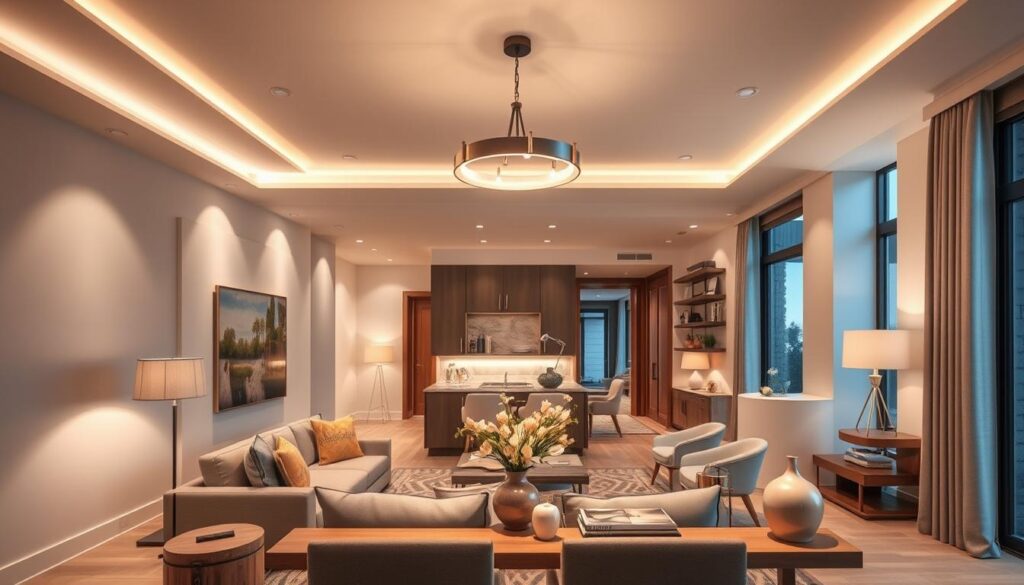
Knowing about different lighting types and how to mix them helps create a balanced look. This balance between natural and artificial light improves your home’s design.
Textiles and Accessories for Comfort
Textiles and accessories are key in interior design. They add comfort and style to any room. They can change a space, making it feel more welcoming and personal.
Choosing the Right Curtains and Rugs
Curtains and rugs are essential in a room’s design. They add color and texture and set the mood. When picking curtains, think about the light and privacy you need.
For rugs, consider the room’s use and your flooring. A plush rug warms a bedroom, while a durable one is better for living rooms.
Experts say the right curtains and rugs are crucial. They should match your decor. For more design ideas, visit Satori Loka.
Pillows and Throws: Comfort and Style
Pillows and throws add comfort and style. They come in many materials, patterns, and colors. They’re great for adding color, texture, or making seats inviting.
Tips for using pillows and throws effectively:
- Mix different patterns and textures for interest.
- Choose materials that are comfy and fit the room’s use.
- Use them to tie the room’s color scheme together.
Wall Art and Decor to Enhance Spaces
Wall art and decor are vital for a room’s look. They add personality, create focal points, and set the mood. Pick art that fits your room’s style and color.
Artless rooms lack soul. Wall art can be paintings, prints, photos, or sculptures. Choose pieces that speak to you and match your space.
By choosing the right textiles and accessories, you can make your home beautiful, comfy, and welcoming. It’s the small details that count the most.
Sustainable Design Choices
More and more people are worried about the environment. Homeowners are now focusing on sustainable design. This is a big step towards reducing our impact on the planet.
Eco-Friendly Materials and Products
Choosing eco-friendly materials is key in sustainable design. This means using recycled, recyclable, or sustainably sourced items. For example, furniture made from reclaimed wood or bamboo helps a lot.
- Recycled Materials: Look for products made from recycled materials, such as recycled glass or metal.
- Sustainable Wood: Opt for wood that is certified by organizations like the Forest Stewardship Council (FSC).
- Low-VOC Paints: Use paints with low volatile organic compounds (VOCs) to improve indoor air quality.
Benefits of Sustainable Practices
Using sustainable design is good for the planet and for us. It makes our homes healthier, uses less energy, and looks great. It shows we care about the environment.
Some big benefits include:
- Energy Efficiency: Sustainable design uses less energy, thanks to things like LED lights and solar panels.
- Healthier Living: It uses safe materials and improves air, making our homes better for us.
- Cost Savings: Using less energy means lower bills, saving us money.
Tips for Upcycling in Design
Upcycling is a fun way to reuse old things. It makes our homes unique and helps the planet. Here are some ideas:
- Repurpose Old Furniture: Turn an old door into a coffee table or use an antique ladder as a bookshelf.
- Use Natural Elements: Add branches, rocks, or shells to your decor.
- Get Creative with Textiles: Make throw pillows, table runners, or wall hangings from old fabrics.
By choosing sustainable design, we can make homes that are beautiful, useful, and kind to the planet.
Creating Cohesion in Your Design
A well-designed home is more than just pretty rooms. It needs a smooth flow that connects everything beautifully.
To get this flow, we must focus on a few key areas. First, let’s look at how to link different rooms smoothly.
Flow and Connectivity Between Rooms
The connection between rooms is key for a unified design. It’s about how easy it is to move from one area to another. Using the same flooring everywhere helps a lot.
Visual connections between rooms are also important. This can be done with a consistent color scheme or matching design elements. For example, a bold piece in one room can be mirrored in another, creating harmony.
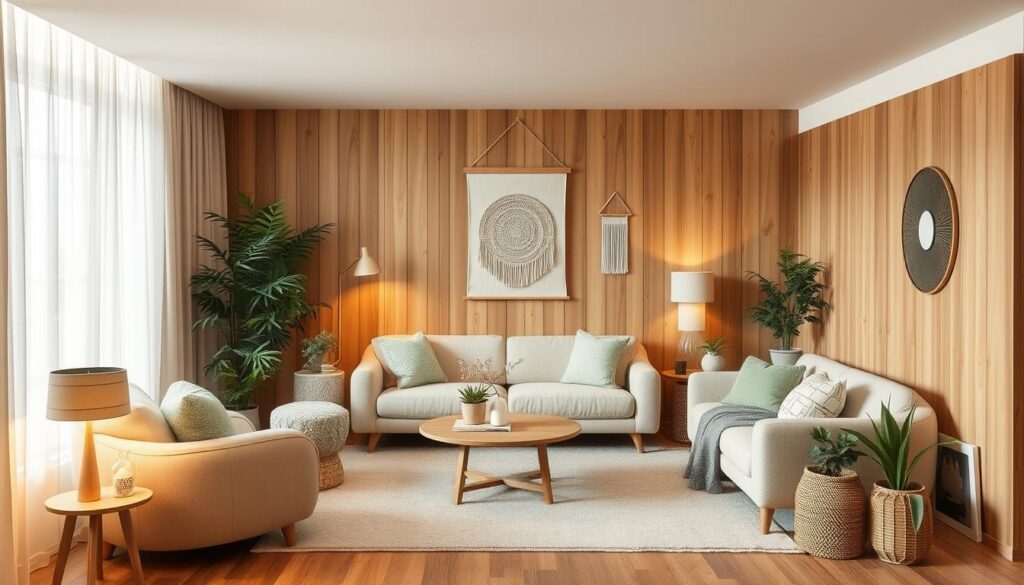
The Role of Focal Points
Focal points add interest and guide your eye through the home. They can be a standout piece of furniture, a striking artwork, or a well-designed fireplace. The goal is to make these points lead your eye through the space.
When designing, pick focal points in each room to create a visual path. A bold art piece in one room can be matched in another, linking the spaces visually.
Using Repeat Elements Effectively
Repeating design elements helps tie your home together. This can include colors, textures, or motifs. It creates a sense of unity and rhythm.
For example, using the same lighting fixtures in different rooms adds consistency. Repeating textures, like certain woods or fabrics, also strengthens cohesion.
By focusing on flow, using focal points, and repeating elements, we can make our home look stylish and welcoming.
Incorporating Technology in Design
Smart home features and tech integration are changing how we live in our homes. They make our homes more fun and useful.
As tech gets better, adding new features to our homes is easier. This makes our homes look better and work better too.
Smart Home Features
Smart home tech lets us control our homes from anywhere or with our voice. Some key features include:
- Voice-controlled lighting systems
- Thermostat control for the perfect temperature
- Security cameras and doorbells with cameras
- Smart locks for better security
- Home entertainment systems that can be controlled from one place
These features make our lives easier. They also help save energy and keep our homes safe.
Design Considerations for Tech Integration
When adding tech to our homes, we must think about how it looks. We want the tech to fit with the home’s style.
Important things to consider are:
- Hiding wires and cables for a clean look
- Picking devices that match our home’s look
- Making sure smart devices are easy to use
“The future of home design is not just about looking good, it’s about being smart and efficient.”
Balancing Tech and Aesthetics
One big challenge is finding a balance between tech and looks. We want our homes to be both smart and beautiful.
| Design Element | Tech Integration | Aesthetic Consideration |
|---|---|---|
| Lighting | Smart lighting systems | Color temperature and brightness |
| Security | Smart locks and cameras | Discreet placement |
| Entertainment | Home theater systems | Speaker placement and screen size |
By thinking about both tech and looks, we can make homes that are both smart and stylish.
Outdoor Space and Interior Continuity
Outdoor spaces are now a big part of our homes. We aim to blend indoor and outdoor areas smoothly. This makes our homes look better and work better too.
Designing Functional Outdoor Areas
When making outdoor areas, think about how you’ll use them. Whether for eating, relaxing, or fun, the design should match. Adding comfy seating, good lighting, and the right furniture makes these areas welcoming.
Outdoor kitchens and dining spots are getting more popular. They let us enjoy meals outside. It’s key to pick materials that last and look good with the inside of our homes.
Connecting Indoor and Outdoor Spaces
Making indoor and outdoor areas feel connected is more than looks. It’s about making it easy to move between them. Big sliding glass doors or bi-fold doors help join these areas together.
Using the same flooring or colors inside and out helps too. For example, hardwood floors that go from inside to the patio make a smooth transition.
Landscaping Tips for Cohesion
Landscaping is key to linking indoor and outdoor spaces. Picking plants and elements that match the inside decor helps. Choosing plants with colors or textures that echo the interior decor is a good way to do this.
Also, using stone or brick that matches the home’s exterior and interior helps. Water features or outdoor lighting add to the harmony between inside and outside.
Final Touches for a Polished Look
As we wrap up our guide to home interior design, it’s clear that the final touches make a big difference. A well-designed home is not just about the big elements. It’s also about the small details that tie everything together.
Simplifying with Decluttering
Decluttering is a key step in adding those final touches. By getting rid of things we don’t need, we create a clean and calm space. Regular decluttering keeps our space feeling polished and serene.
Elevating with Accessories
Accessorizing is also crucial for finishing our home. Thoughtfully arranging decorative items adds personality and style. This can include vases, artwork, or unique pieces that show our taste.
Keeping it Fresh with Seasonal Updates
To keep our space feeling fresh, we can make seasonal updates. This might mean swapping throw pillows, adding seasonal decor, or changing our color palette. These small changes keep our home stylish all year round.

